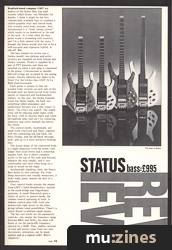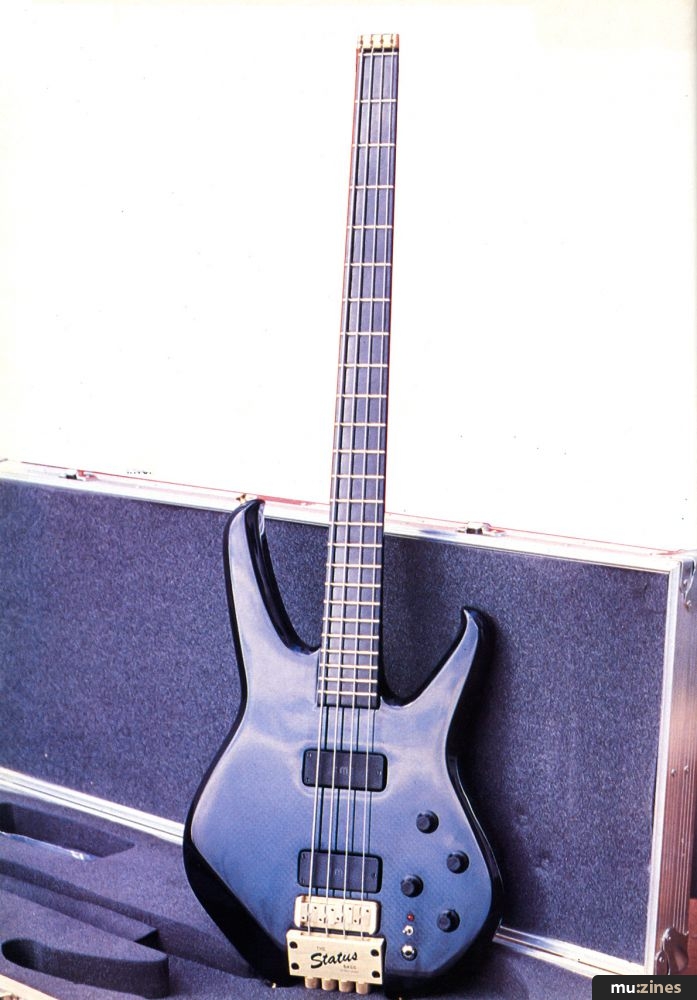Magazine Archive
Home -> Magazines -> Issues -> Articles in this issue -> View
Status Bass | |
Article from One Two Testing, February 1984 | |

Romford-based company GMT are makers of the Status Bass (up until recently called Strata — see Shredder for details). I think it might be the first commercially available bass to combine a carbon graphite neck and central body with wooden outer-body sections. Also incorporated is a "body tuning system" which results in no headstock at the end of the neck. At a time when the bass guitar world is brimming with esoterica and I'm a little tainted with the years, I thought the Status would turn out to be a well-executed and expensive hybrid. A one-off. But...
The bass loaned for review was a fretless model; two pickups and active circuitry are standard on both fretted and fretless versions. Power is supplied by a pair of PP3 batteries and these are switched on when a jack plug is connected to the guitar. Conventional or double-ball-end strings are accepted by the tuning system, thereby allowing any make to be fitted. For the fretless bass GMT fit La Bella Quarterwounds.
Each guitar is unique in that the wooden body sections on each side of the through-neck are hand-carved from exotic species of imported and bookmatched timbers. In this case, the facing (topside) wood was flame maple, the back was something called amazaque, and sandwiched between was a thin veneer of ebony. The effect was superb. The maple front will be pleasing under lights while the back, with its discreet black and white herringbone inlay and cat's fur colouring, shimmers and swirls beneath the mirror-like finish.
The control knobs, incidentally, are made from rosewood and these, together with the contrasting top and back, the brass fittings, and the all-black through-neck, add up to a most attractive looking bass.
The actual shape of the contoured body is a slight departure from the norm, with longer than usual horns and a somewhat angular look, but it allows complete access to the top of the scale and beyond, balances the neck ideally, and is very comfortable and close when hung on a strap or rested on the thigh.
Aesthetically speaking, then, the Status Bass defies its own concept. Far from being innovative but visually monstrous, it looks really good, despite the lack of a headstock.
Four control knobs process the output from GMT's Solid Humbuckers, located at the usual bridge and fingerboard positions. A small flickswitch gives a choice of active or passive mode, the volume control operating in both. A balance control pans fully from one-pickup-only right across to the other, giving infinite tonal possibilities. There's a centre detent to indicate equal output.
The last two knobs are the parametric controls — one sweeps the frequency range between 80Hz and 5kHz, the other will boost or cut the particular frequency selected by ±18dB. Thus, endless varieties of tone and power come from two easy movements: alterations can be made quickly and in a logical order. Bravo simplicity!
Output trom the bass comes via a front-mounted jack socket. On the fretted version of the Status the parametric section is replaced by conventional bass and treble controls which GMT claim make more sense of the tonal response produced by frets.
A gentle but acceptable level of hiss is present in the active mode, but bear in mind that this is with everything flat out in the treble department, including 18dB of boost at 5k. Hum, buzz and howl, on the other hand, are conspicuous by their absence, which implies a competent screening job (something unheard of in some quarters). I doubt that any problems will arise from stage lighting, studio or PA systems.
Now let's move on to the neck and tuning system. The substantial solid brass metalwork (ie the nut/string anchor, the bridge and the tuner/tailpiece) has been carefully satin-lacquered and should resist discolouration for many years. The neck/vestigial body is moulded chiefly from carbon graphite and is topped with the highest quality phenolic fingerboard. The shape of the neck has been based on that of a Precision, so the fingerboard and playing area is quite wide but remarkably shallow.
High speed playing is a breeze and there's plenty of room for the fingers to move. Finish on the neck is a very hard black gel coat which further aids swiftness of playing. The bridge and tuner/tailpiece are bolted directly into the moulding and the nut/string anchor caps the top end of the neck. The sustain produced by this method prods the limits of the laws of physics, and the carbon graphite composite will not bend, twist or warp, and is unaffected by temperature. Its rigidity renders it more or less indestructible. Position markers are brass-coloured dots on the side of the fingerboard. Truss-rods, bolts, tilt adjustments, and machine heads are nonexistent on the Status Bass neck.
Tuning is taken care of with great accuracy at the other end of the guitar, utilising the direct-pull system established by Steinberger. The massive bridge and nut/string anchor closely resemble those of the latter instrument — as GMT are the first to admit — and the GMT version complements a design that was "right" to begin with: refinements have been made.
For instance, the slightly fiddly "jaws" on the Steinberger tuners have been replaced with brass "trays". To change strings now, all you do is detune, lift the ball-end from the "tray" and discard the string. The new string is then laid on the guitar and the ball-end is placed in the "tray" which retracts into its housing as you tune up. The time involved in replacing the string and retuning is now literally a matter of seconds.
The irony (and most laudable aspect) of all this State Of The Art Technology is that the player will find him/herself oblivious to its existence. And that's exactly as it should be. I found the Status Bass to be such a good instrument that all I wanted to do was play it. From way down low to the highest highs, the guitar seems to speak. Every vibrant note sounds as if it has been voiced individually.
The neck simply makes you stretch and run and manoeuvre where you'd never normally go — it encourages the left hand to go for those difficult figures which more often than not seem to work on this bass.
I'm not going to attempt to describe the tonal capabilities of the Status — versatile is a sufficient word. Even in the passive mode, with the pickups on equal output, this is a superlative bass sound, no question.
In terms of design, appearance, tone and playability, I just can't fault the bass. The level of workmanship is quite stunning, and taking into account the high costs involved in manufacture the price is fairly justifiable. Regardless and yet because of its outstanding and unusual technical features, this very "musical" instrument succeeds with flying colours. The Status Bass earns my highest recommendation. Hats off to GMT.
£995
Featuring related gear
GMT Status Bass Series 2000 - Basscheck
(IM Jul 85)
Status 2000
(12T Mar 85)
Browse category: Bass > GMT
Publisher: One Two Testing - IPC Magazines Ltd, Northern & Shell Ltd.
The current copyright owner/s of this content may differ from the originally published copyright notice.
More details on copyright ownership...
Review by Andrew Bodnar
Help Support The Things You Love
mu:zines is the result of thousands of hours of effort, and will require many thousands more going forward to reach our goals of getting all this content online.
If you value this resource, you can support this project - it really helps!
Donations for April 2024
Issues donated this month: 0
New issues that have been donated or scanned for us this month.
Funds donated this month: £7.00
All donations and support are gratefully appreciated - thank you.
Magazines Needed - Can You Help?
Do you have any of these magazine issues?
If so, and you can donate, lend or scan them to help complete our archive, please get in touch via the Contribute page - thanks!






